The 10 Science ‘Must Knows’ on Climate Change
Prepared by the Earth League and Future Earth for the United Nations Framework Convention on Climate Change (UNFCCC) 23rd Conference of the Parties (COP23), 2017.
The Paris Agreement aims to hold “the increase in the global average temperature to well below 2 °C above pre-industrial levels” and pursue efforts “to limit the temperature increase to 1.5 °C above pre-industrial levels”. In 2016, global average surface temperature reached about 1.1 °C above pre-industrial levels, making it the warmest year on record1. Globally averaged concentrations for carbon dioxide (CO2) reached 403.3 parts per million in 2016, up from 400.0 ppm in 2015. This is a record annual increase2. The science is clear that meeting the Paris Agreement will require rapidly ridding society of fossil fuels. In addition, the world will have to safeguard and enhance existing carbon sinks, and major efforts will be needed to build societal resilience in the face of unavoidable climate change.
The following statements summarise key scientific insights relating to the Paris Agreement and economic and policy options that would help us reach these goals. These statements show that the climate challenge must be positioned in the larger context of global sustainability. With the 23rd Conference of the Parties taking place in Bonn in November, these statements are intended to provide climate negotiators, policy makers, and business leaders with an evidence-based briefing to advance solutions for a manageable climate future.
The full report can be found here.
Watch a video of a press briefing unveiling this report at the Bonn Climate Change Conference (COP23):
- Evidence shows that Earth has entered a new geological epoch – the Anthropocene – with profound implications for humanity and the relative stability of the Earth system.
- Earth is approaching tipping points due to human pressures.
- Risks of extreme weather are increasing.
- Rising sea levels and ocean acidification are growing threats.
- The costs of climate change are already being felt today and will increase in the future.
- Human health is at risk from air pollutants that alter the climate, and the impacts of a changing climate, which are decreasing food security and increasing the risks of disease and heat stress.
- Climate change is likely to exacerbate the risk of large-scale migration and civil unrest.
- The world needs to act faster: deeper cuts are needed to reduce risk of global average temperature rising 2 °C above pre-industrial levels. A pathway of halving global emissions every decade is consistent with this goal.
- Analyses suggest that it is possible for the world to meet Paris Agreement targets if nation states cooperate and coordinate mitigation efforts. Carbon pricing is an important policy tool that would create substantial revenues amounting to potentially several percent of GDP.
- Adaptation and resilience building are necessary even if the world succeeds with aggressive international action to reduce emissions of greenhouse gases.
-1-
Evidence shows that Earth has entered a new geological epoch – the Anthropocene – with profound implications for humanity and the relative stability of the Earth system.
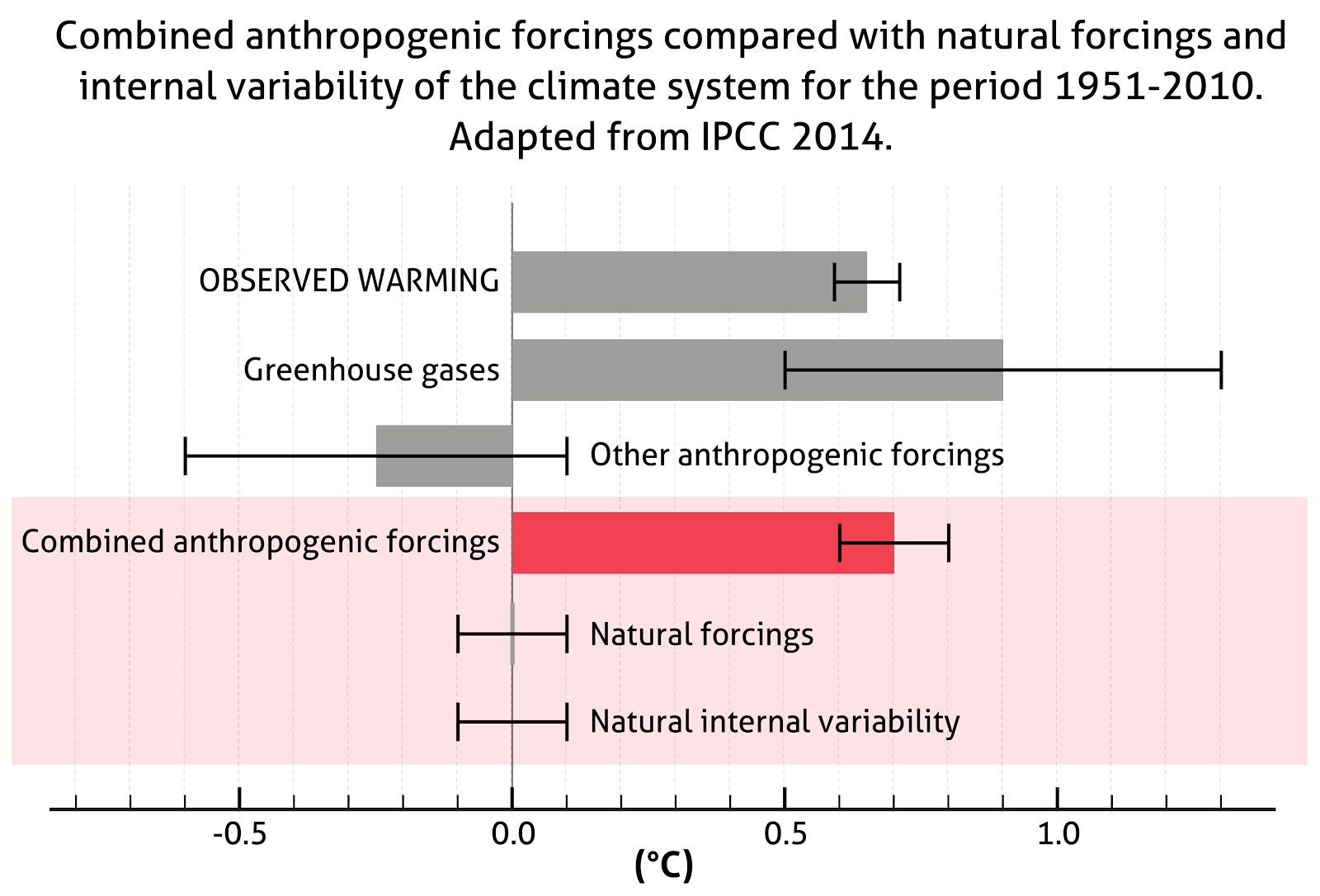
A defining characteristic of the last 11,000 years, a period in Earth history geologists call the Holocene, has been global climatic stability. Global average surface temperature, for example, has fluctuated plus or minus 1 °C3. Agriculture and our advanced civilisation emerged against the backdrop of this relatively stable climate.
Evidence from many lines of inquiry now indicates that human influence is so substantial that Earth is no longer in the Holocene, but rather in a new geological epoch, the Anthropocene4. Evidence ranges from rising atmospheric concentrations of greenhouse gases, ocean acidification, ozone depletion, biodiversity loss, and alterations to the carbon, water, and nitrogen cycles.
The land and oceans absorb approximately 50% of human-induced CO2 emissions. So far, despite an exponential rise in human pressures since the 1940s-1950s, these sinks have moderated human influence on the climate. Deforestation and agriculture are weakening land carbon sinks.
2015 and 2016 saw record increases in the accumulation of atmospheric CO2 due to CO2 emissions and a weaker carbon sink on land in response to El Niño. El Niño is now over but the 2017 projection for atmospheric CO2 is above the past decadal average. This is a concern5.
Weakened carbon sinks will hamper efforts to remain below 2 °C6. This suggests that succeeding with the Paris Agreement is closely coupled with succeeding in implementing the UN Sustainable Development Goals (SDGs), which set out a roadmap for a transformation to global sustainability for both people and planet.
Earth is approaching tipping points due to human pressures.

We should not expect climate change to happen incrementally. In the past, large parts of the Earth system, such as ice sheets, rainforests, and oceans, have shifted abruptly following long periods of incremental change7. Expected future abrupt changes might cross thresholds or tipping points that may be irreversible and may have large negative implications for human populations. Research suggests three temperature ranges of concern for tipping points8:
Tipping elements that may be crossed at a 1-3 °C rise in global average surface temperature (note: these levels are within the range of the Paris Agreement targets)
- Loss of Arctic summer sea ice
- Irreversible melting of parts of the Greenland Ice Sheet
- Irreversible melting of the West Antarctic Ice Sheet
- Loss of many warm-water coral reefs
- Disappearance of many mountain glaciers
Tipping elements that may be crossed at 3-5 °C
- Significant parts of the Amazon shift from rainforest to savanna
- Boreal foresst: large-scale ecological and shifts affecting regional warming
- Influence on the thermohaline circulation, in particular slowdown of the Atlantic Meridional Overturning Circulation
- Changes to strength and frequency of the El Niño-Southern Oscillation
- Greening of the Sahel
Tipping elements likely beyond 5 °C
- Irreversible melting of the East Antarctic Ice Sheet
- Melting permafrost and release of methane
- Loss of Arctic winter sea ice
Risks of extreme weather are increasing.
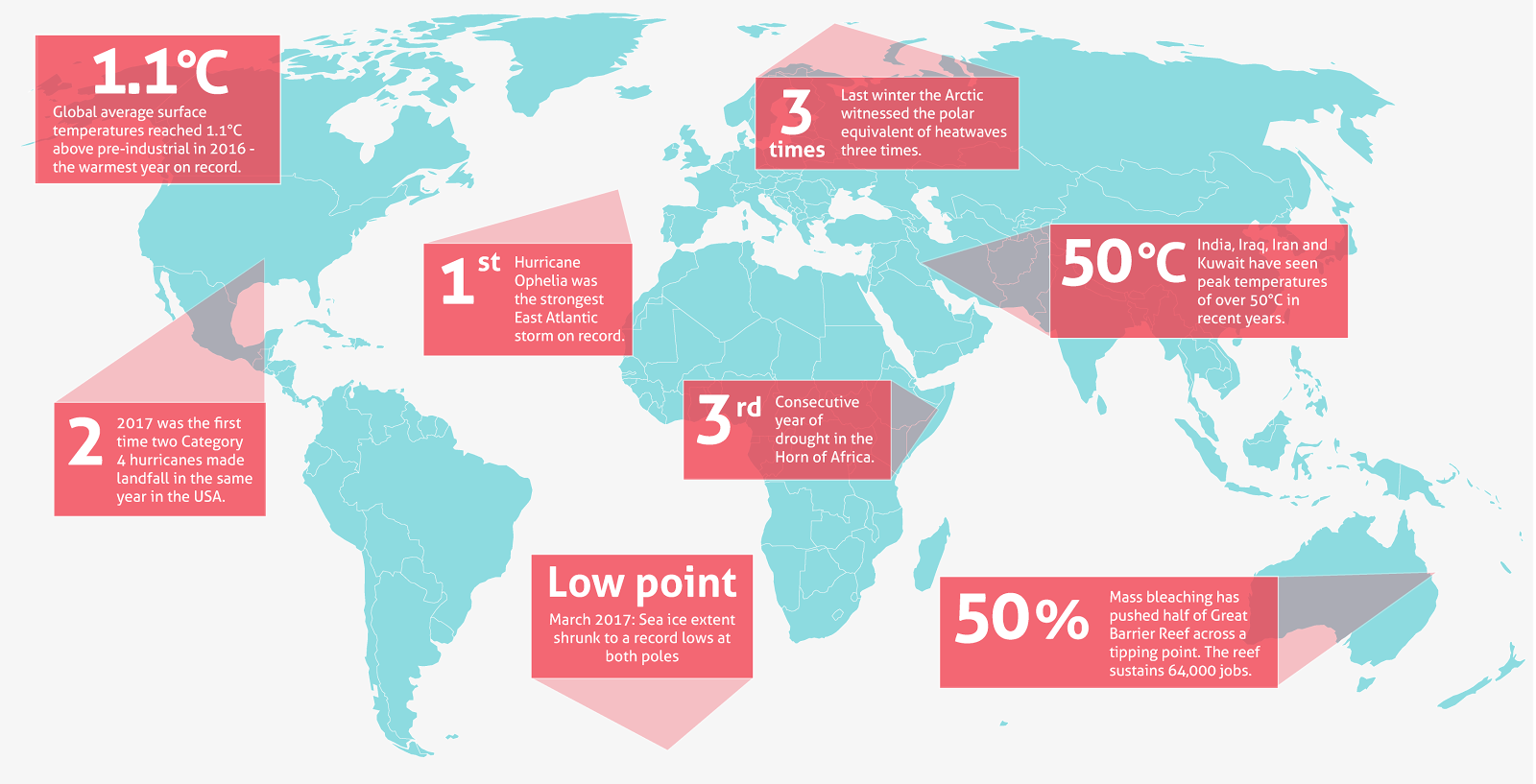
The record-breaking 2017 Atlantic hurricane season9 is a glimpse into the changing risks of the Anthropocene. Energy is accumulating in the oceans and atmosphere as a result of human greenhouse gas emissions10 and the associated global warming. The increasing energy is amplifying the hydrological cycle and influencing tropical storms by supplying them with more energy. These increasing environmental pressures are further exacerbated by urban development, which is intensifying in vulnerable regions such as flood zones.
Long-term observations suggest that heatwaves have become more frequent in the last 50 years in large parts of Europe, Asia, and Australia11. It is also likely that the numbers of extreme rainfall events over land have increased in many regions over the past few decades12, most markedly in Southeast Asia (+ 50%) but also in Europe (+ 30%)13. The rise in extreme weather events, already at 1.1 °C global warming, have significant social and economic implications with rising mortality levels due to heatwaves (see statement 6 below). Weather-related disasters may affect two-thirds of the European population by 2100 compared with 5% in 1980-2010 under business as usual conditions14.
Rising sea levels and ocean acidification are growing threats.
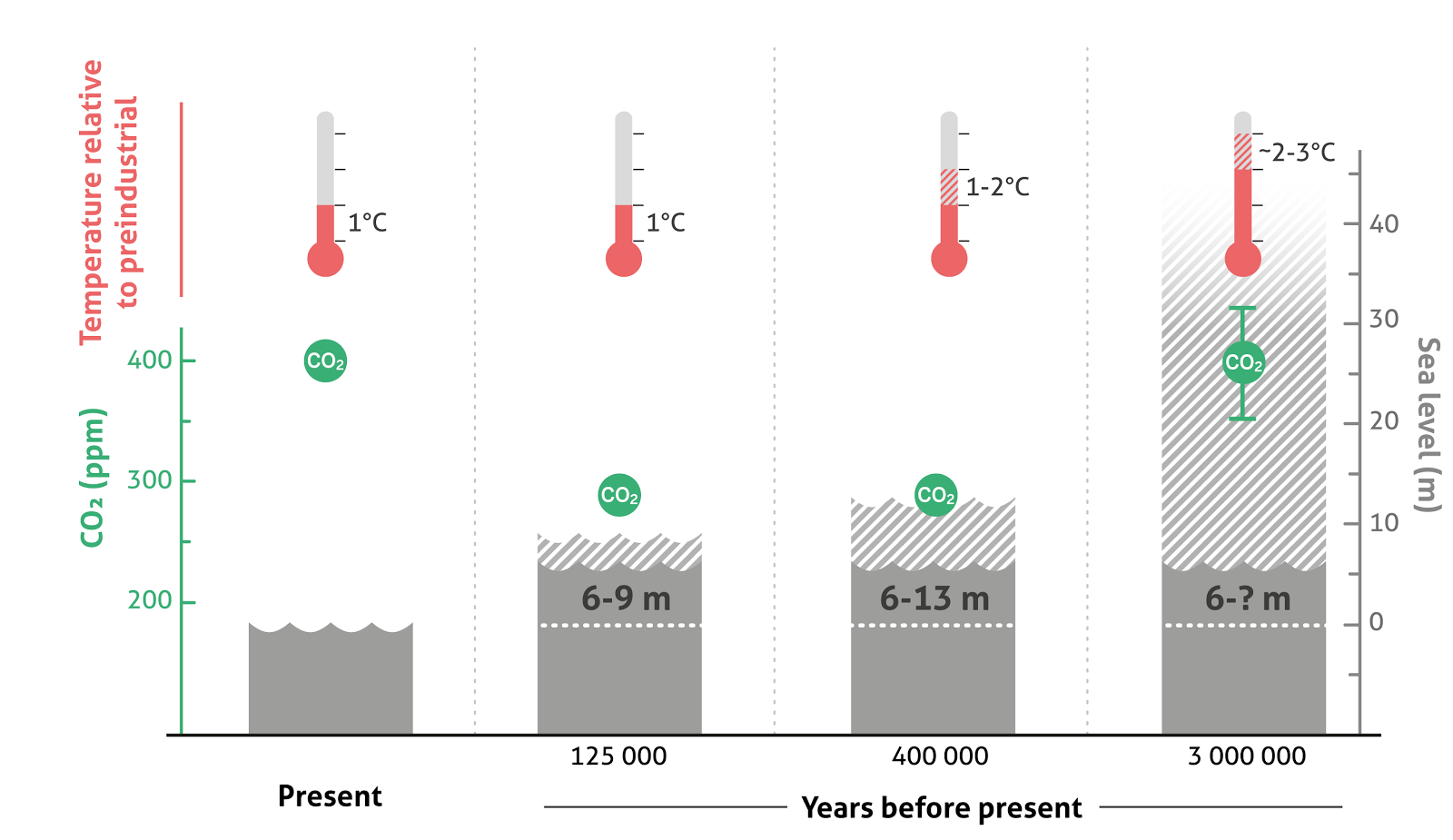
Sea-level rise
The ocean stores 93% of the additional heat trapped in the climate system by greenhouse gases emitted by human activities15. The resulting warmer waters expand causing sea levels to rise. Melting glaciers and ice sheets also contribute to sea-level rise. Sea levels will continue to rise while greenhouse gas emissions continue, and levels will not stabilise until centuries after stabilisation of greenhouse gas emissions16.
By the end of the century, global average sea levels are projected to rise about one metre, presenting substantial challenges for coastal protection in places ranging from Florida to Bangladesh17. If emissions continue unabated, meltwater from Greenland and Antarctica will, eventually, dominate sea-level rise. These ice sheets are estimated to lead to more than two metres of sea-level rise per degree of global warming18.
Ocean acidification
Ocean uptake of CO2 from emissions from human activities is causing the chemistry of the oceans to change. Ocean acidification is occurring at unprecedented rates. The last time the pace of ocean acidification came close to current rates was 56 million years ago and coincided with very significant changes in ocean ecosystems that have been described as a major extinction. Ocean acidification is progressing faster today by an order of magnitude than it did at that time19. Scientists are already seeing negative effects of ocean acidification on food webs. However, it is an open research question how ocean acidification will, ultimately, affect food webs, starting with plankton, the basis of life in the sea20.
The costs of climate change are already being felt today and will increase in the future.
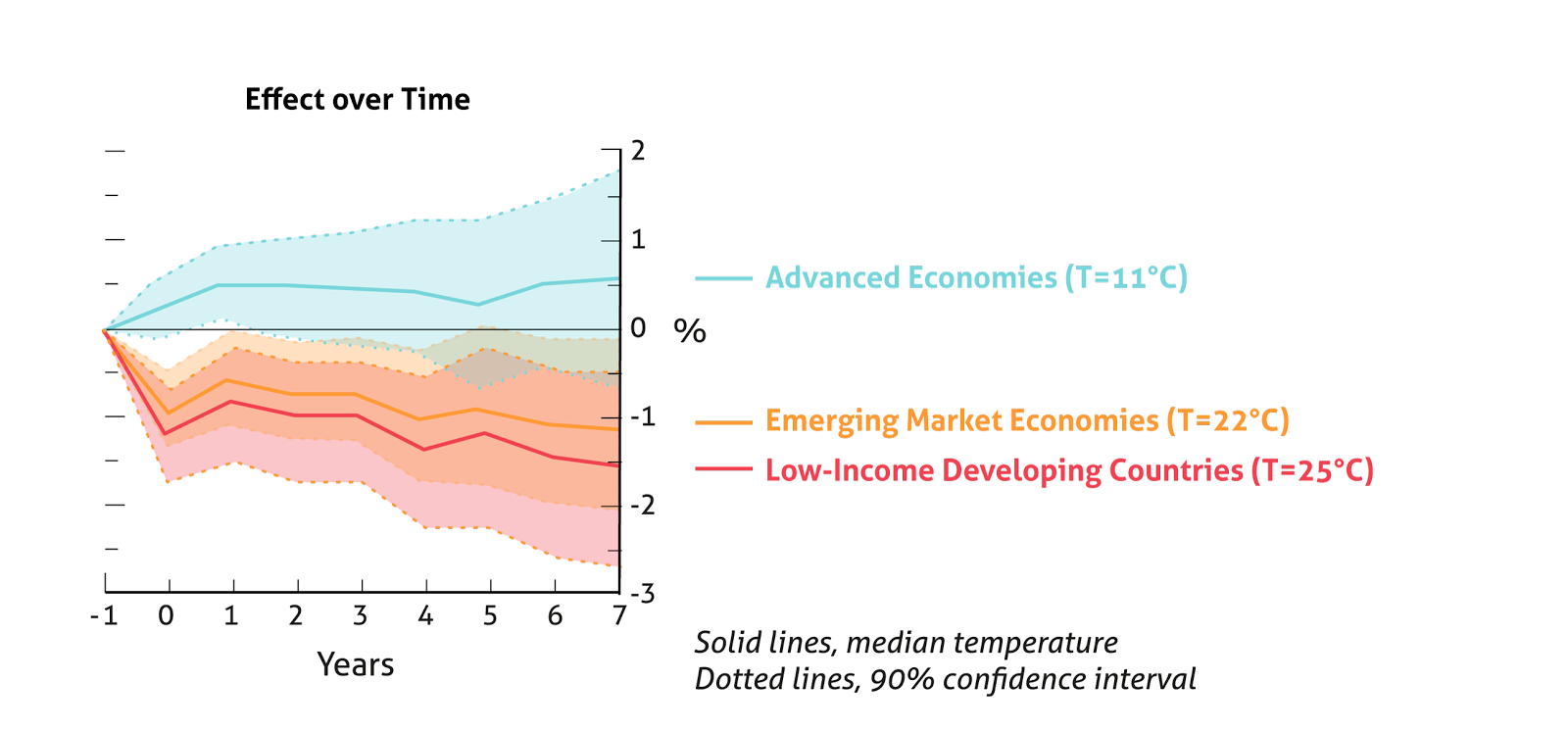
Changes in the climate in recent decades have caused impacts on natural and human systems on all continents and across the oceans21. However, the impacts have been uneven. The lowest-income nations, which have contributed little to global greenhouse gas emissions, will bear the brunt of the adverse consequences of climate change, since they tend to be situated in some of the hottest regions of the planet. An International Monetary Fund (IMF) analysis indicates that a 1 °C increase in temperature in a country with an average annual temperature of 25 °C – such as Bangladesh, Haiti, or Gabon – would reduce per-capita output by up to 1.5%22. Accordingly, if global warming emissions continue unabated the resulting temperature rise would cut about one-tenth of the per-capita output of median low-income economies23.
Air pollutants such as black carbon and tropospheric ozone are altering the climate and also have substantial, direct negative effects on human health24. Analyses suggest that the total lost economic value from global climate-altering pollutants in the form of particles is roughly US$1.9 trillion annually. In this sense, the world ought to be willing to pay this much to reduce it. This is about 2.7% of the global economy, which amounted to approximately US$70 trillion in 201025.
The negative effects of unmitigated climate change, through rising temperatures, shifting precipitation patterns, more frequent natural disasters, and rising sea levels are not limited to the poor. The economic impacts of these effects are already being felt in more developed regions of the world and are expected to continue to rise. For example, recent analyses suggest that over the next 15 years, higher sea levels combined with storm surges are likely to increase the average annual cost of coastal storms along North America’s Eastern Seaboard and the Gulf of Mexico by US$2-3.5 billion26.
Human health is at risk from air pollutants that alter the climate, and the impacts of a changing climate, which are decreasing food security and increasing the risks of disease and heat stress.
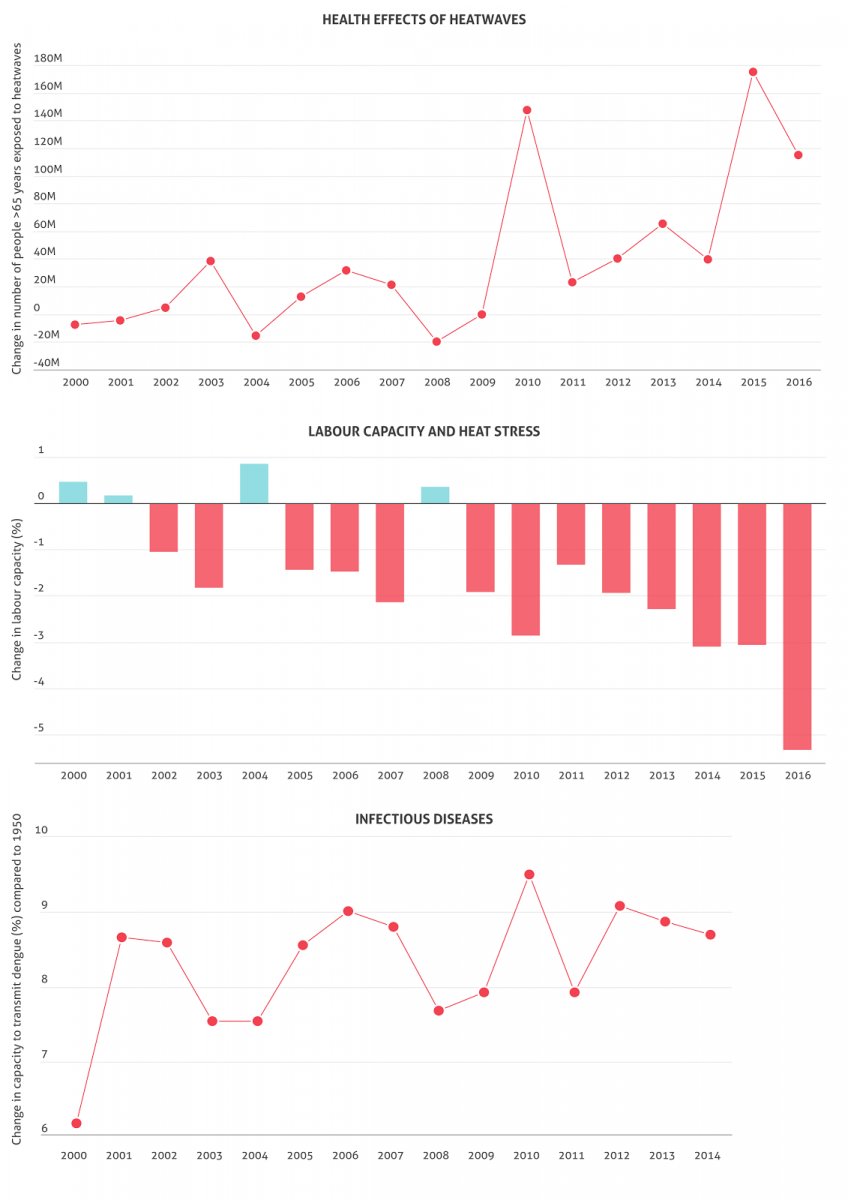
The health of human populations is sensitive to shifts in weather patterns and other aspects of climate change. Research suggests that rising temperatures have already increased the risk of heat-related death and illness. For example, analysis suggests that human-caused climate change at least doubled the likelihood of the 2003 European heatwave27, which caused up to 70,000 premature deaths28. And local changes in temperature and rainfall have altered the distribution of some water-borne illnesses and disease vectors and have caused reduced food production in some vulnerable populations29.
Climate-altering air pollutants such as black carbon and tropospheric ozone also have substantial, direct, and negative effects on human health30. In fact, these pollutants are among the largest health-risk factors globally31.
Looking forward, accelerating changes in Earth’s natural systems are a significant threat to human health and livelihood as a result of possible impacts on nutrition, food availability, respiratory diseases, and the spread of parasites. For example, a recent estimate suggests that crop-yield losses could be 3-7% per degree of warming32. Furthermore, climate change coupled with population growth and development patterns is increasing stresses on global water resources. By 2050, more than half of the world’s population will live in water-stressed areas, and a billion or more will not have sufficient water resources33.
These health threats will become increasingly severe over time without steps to reduce the risks34. Areas with weak health infrastructure – mostly in developing countries – will be the least able to cope without assistance to prepare for and respond to health emergencies.
Climate change is likely to exacerbate the risk of large-scale migration and civil unrest.
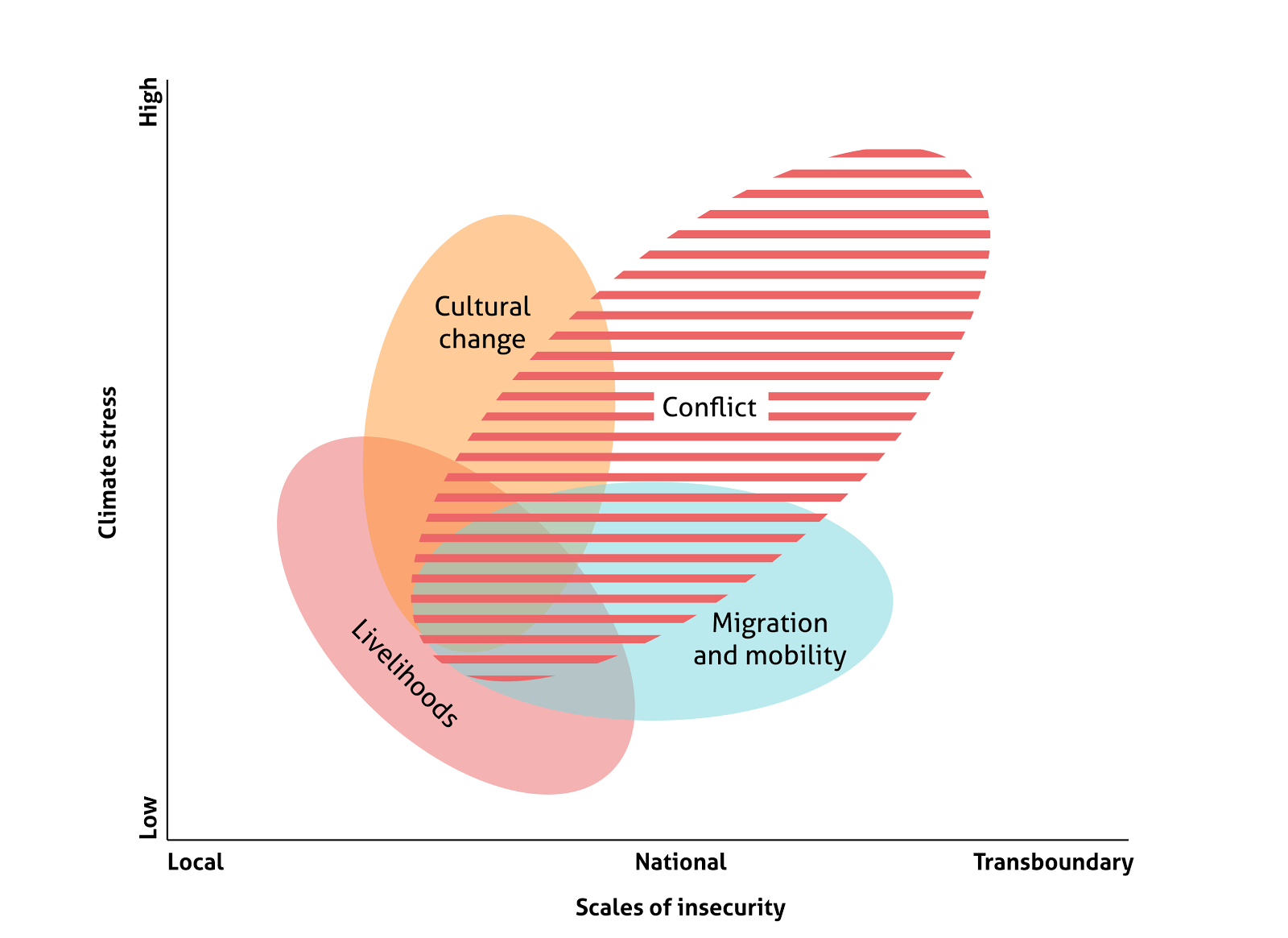
In 2015, more than 19 million people were displaced by natural disasters and extreme weather events35. Recent studies suggest that the changing climate can be expected to further heighten the risks of large-scale migration and civil unrest36. In addition to increasing temperatures, changing precipitation patterns, and extreme weather events, rising sea levels are projected to put millions of people at risk of severe coastal flooding and displacement; the majority of those affected are likely to be in East, Southeast, and South Asia. Together these shifts are anticipated to undermine livelihoods, threaten infrastructure, increase food insecurity, and compromise the ability of states to provide conditions for human security37.
Most links between climate, conflict, and migration are complex and ambiguous, but floods, heatwaves, and droughts can create fragile conditions or exacerbate existing fragile situations. The changing climate is increasing the odds that these fragile conditions will arise and the likelihood that they will be severe.
According to an analysis of three decades of conflict data (1980-2010), about 23% of conflict outbreaks in countries with existing ethnic tensions robustly coincided with climatic events such as heatwaves and droughts. This suggests that natural hazards can significantly reduce resilience in politically fragile societies38.
The world needs to act faster: deeper cuts are needed to reduce risk of global average temperature rising 2 °C above pre-industrial levels. A pathway of halving global emissions every decade is consistent with this goal.
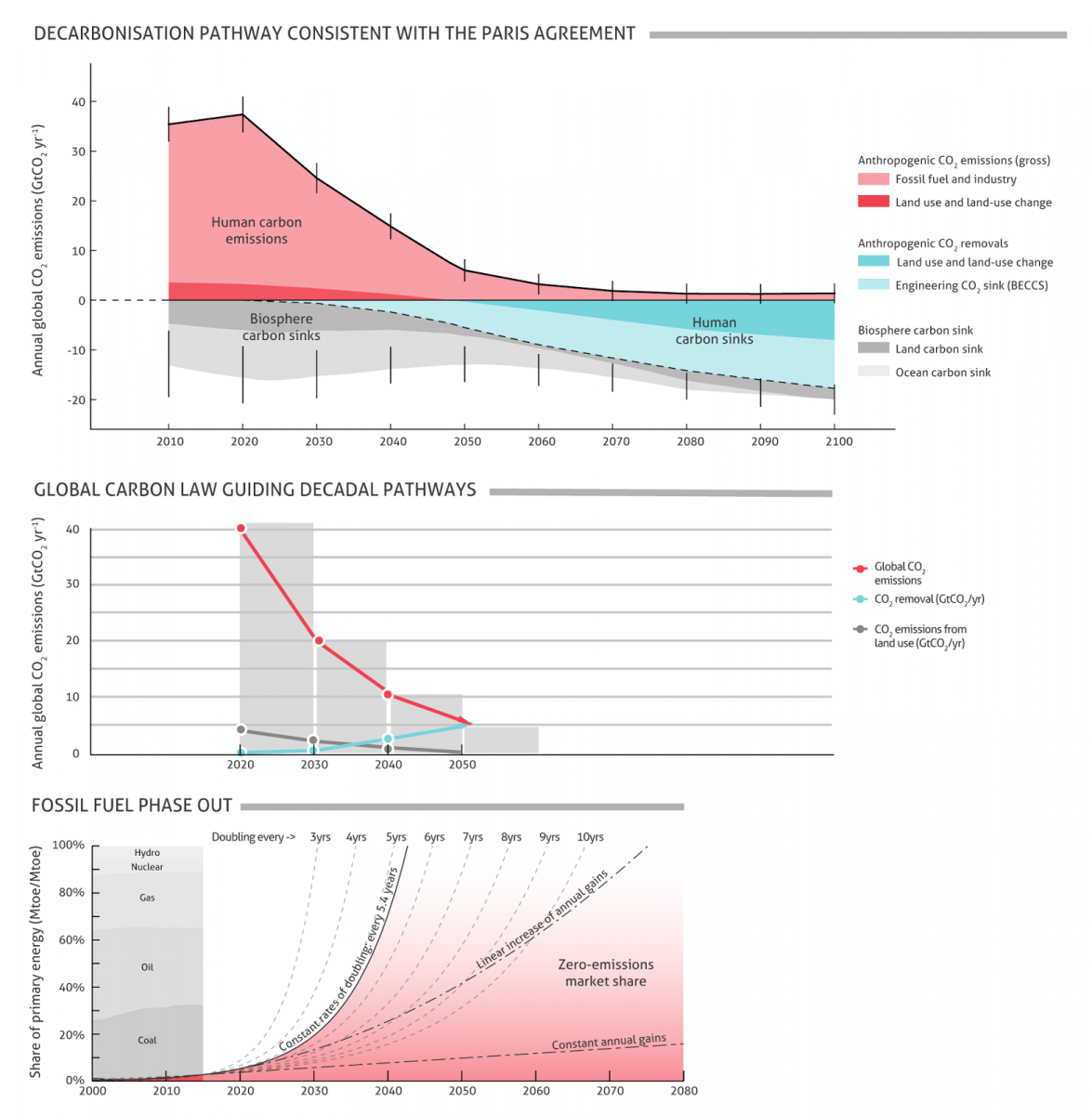
Limiting global average temperature below 2 °C translates to a cumulative carbon budget of approximately 2,895 gigatonnes of carbon dioxide (GtCO2), or 2,162 GtCO2 for 1.5 °C. By 2015, past emissions amounted to 2,052 GtCO2. This leaves a remaining budget of approximately 843 GtCO2 for just a 66% probability of remaining below 2 °C, or 110 GtCO2 to reach 1.5 °C with the same probability. This further translates to approximately 20 years of emissions at rates similar to today (around 40 GtCO2 annually) for a 2 °C target. For the 1.5 °C goal, the budget will be extinguished before 202039.
To substantially reduce the risk of global average temperature rising by 2 °C, global emissions should peak no later than 2020 and approach net zero by 2050-2060. This must also be done in concert with halting deforestation, turning agriculture from carbon source to carbon sink, and protecting existing carbon sinks on ocean and land. Pursuing efforts to limit temperature increase to 1.5 °C is likely to require untried industrial-scale deployment of carbon capture and storage solutions in addition to reducing emissions to approximately zero by 2050-206040. Delaying large-scale emissions reductions by a decade makes the Paris goal almost unattainable41. As a simple rule of thumb, if nations and non-state actors (businesses, cities, etc) set goals to halve their emissions every decade, the world would have a stronger chance of achieving the Paris Agreement42.
Progress is being made. Between 2014 and 2016, there was almost no growth in the magnitude of annual CO2 emissions43, largely due to significant efforts in China. For over a decade, renewable energy expansion around the globe has grown at an exponential rate, doubling around every 5.5 years. This exponential trajectory is consistent with complete decarbonisation of the energy sector by mid-century44.But emissions are projected to rise again on 2017. This is concerning.
Analyses suggest that it is possible for the world to meet Paris Agreement targets if nation states cooperate and coordinate mitigation efforts. Carbon pricing is an important policy tool that would create substantial revenues amounting to potentially several percent of GDP.
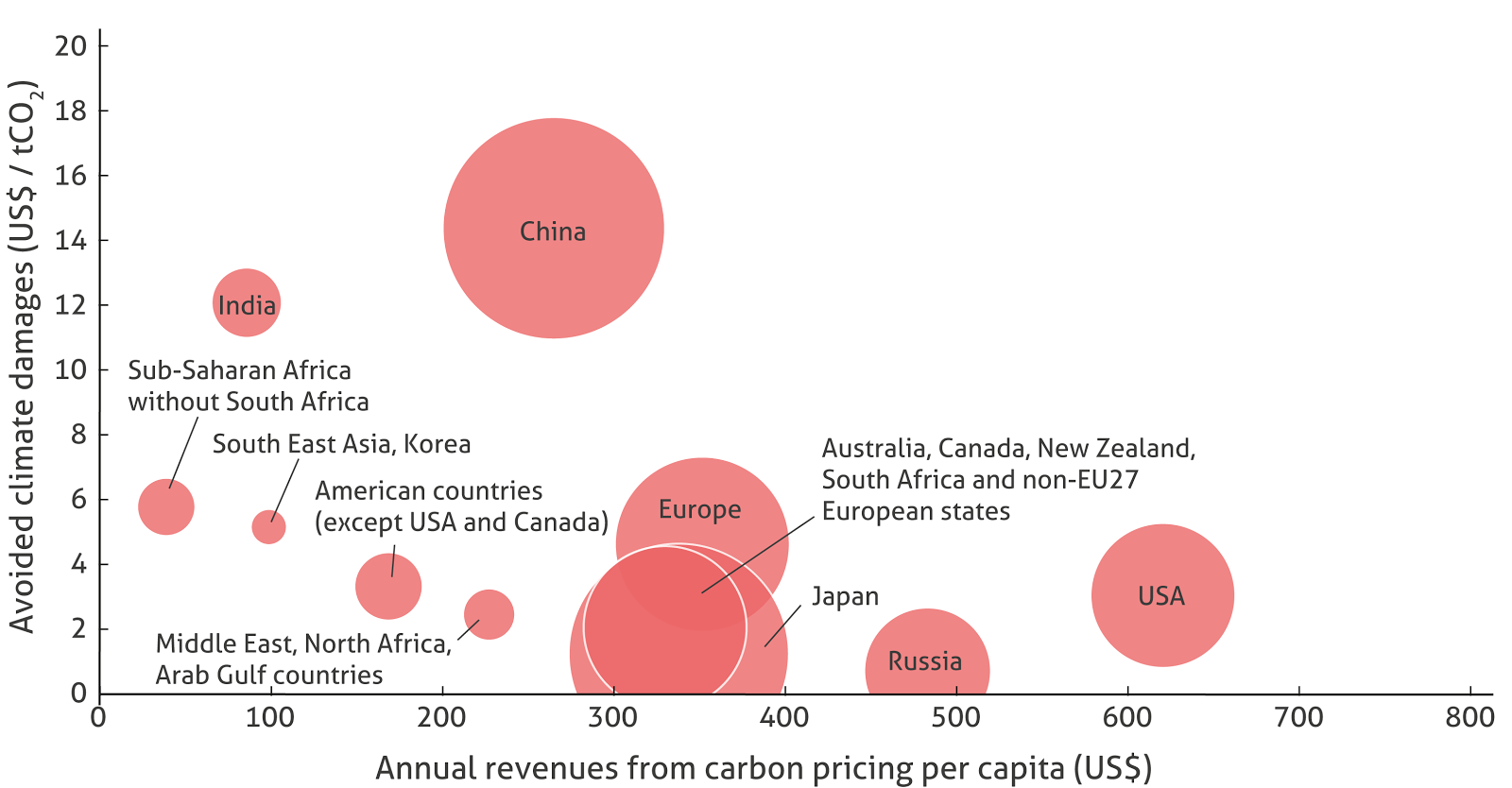
As shown by the Intergovernmental Panel on Climate Change (IPCC) and several global economic analyses45, removing fossil fuels from the world economy to enable world development below 2 °C is feasible. We have the technologies and policy instruments to succeed.
Unmitigated climate change is likely to slow the global economy. The estimated costs range from 2-10% of GDP46 by 2100 to 23% of GDP47 (global average across countries). On the other hand, recent estimates of the cost of removing fossil fuels from the global economy if all mitigation technologies are available and nations cooperate come in at 1-3% of global GDP by 2030 and around 5% by 2100. This comes with significant added benefits: long-term energy security, reduced pollution, improved health, and greater socio-economic competitiveness48.
Decarbonising the world economy will require concerted efforts among all sectors and actors. Carbon pricing is a key policy to level the playing field by making low-carbon energy sources cost competitive and providing an incentive for economic actors to reduce reliance on fossil fuels. Carbon pricing would create substantial revenues amounting to potentially several percent of GDP (Figure 9). Additionally, carbon prices allow for a comparison of national determined contributions (NDCs). As such they are a transparent indicator for national climate policy ambitions, making them a useful tool to increase the mitigation efforts because they establish reciprocity between countries49.
Fossil fuel subsidies are a direct contradiction of the goal of the Paris Agreement. The IMF calculates that global fossil fuel subsidies amount to US$5 trillion annually, when accounting for indirect costs such as health impacts (direct subsidies are circa US$500 billion)50. Framed another way, every ton of CO2 is subsidised by roughly US$15051. Fossil fuel subsidy reform would allow the world to switch from a “negative” carbon price to a price that reflects the true social costs of fossil fuel use due to climate change, for example local air pollution and health.
The prices of renewable technologies, for example wind power, photovoltaics, and battery storage systems, are now low enough to compete favourably with existing fossil-fuel technologies. However, rapid disruption of the global energy system will require sustained and large-scale investment in research and development. This will create the next generation of technologies and keep the world on the exponential trajectory of renewable installation witnessed in the last decade.
Adaptation and resilience building are necessary even if the world succeeds with aggressive international action to reduce emissions of greenhouse gases.
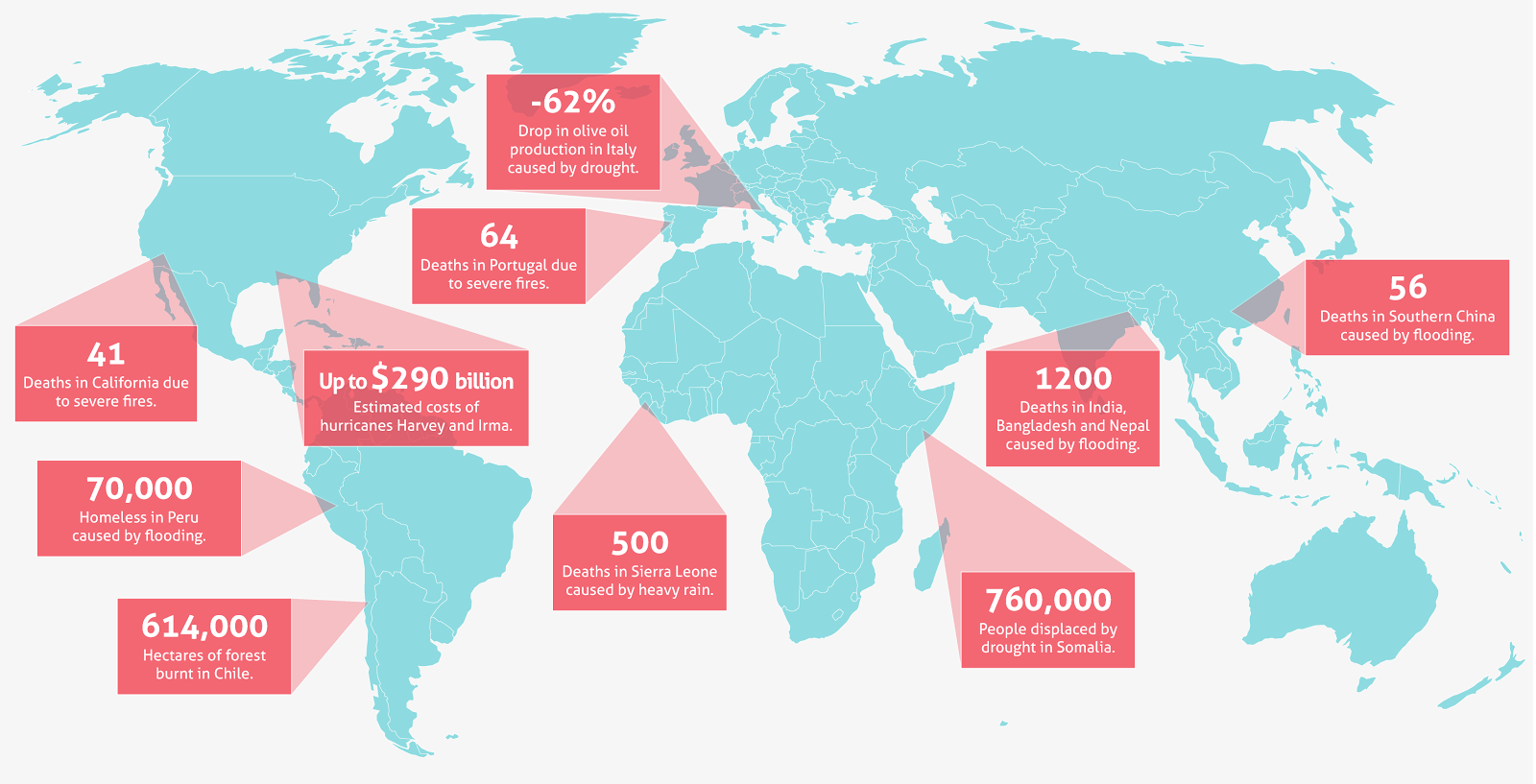
Even keeping temperature rise to below 2 °C above pre-industrial levels, some regions will experience increased risks of rising sea levels, forest fires, and water and food insecurity and may see increases in extreme heat, disease, and weather events. Safeguarding and strengthening the resilience of natural systems, from forests to soils to oceans, as the climate warms will require a global transformation to sustainability.
The evidence is clear that both mitigation and adaptation to climate change are needed to attain a manageable climate future and achieve the SDGs. A mitigation-only strategy will not work because many changes are already under way and are now unavoidable. An adaptation-only strategy will not work as most adaptation measures become more costly and less effective, and in some cases ineffective, as the magnitude of climate change increases52.
The SDGs have provided the world with a roadmap towards prosperity for all citizens on Earth, which calls for a global transformation to sustainability. The cumulative scientific evidence indicates that sustainable development, with transformations to sustainable food systems, decarbonised energy systems, resilient cities, human equity and justice, universal health and education, eradicated poverty and hunger, sustainable consumption and production, healthy oceans, safe water, and protected biodiversity, form a fundamental cornerstone for success in achieving good climate adaptation and climate resilience.
For references, please see the full report.
DATE
November 12, 2017AUTHOR
Future Earth Staff MemberSHARE WITH YOUR NETWORK
RELATED POSTS
Program Now Available for the Year’s Top Sustainability Science and Innovation Event in Finland
Future Earth Members Join UN Ocean Conference in Barcelona
Apply for the 2024 Pathways Autumn School: Transformative Research for a Just World and a Habitable Planet